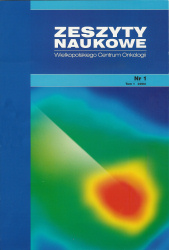Abstract
Weryfikacja rozkładów dawki w brachyterapii stawia przed fizykami medycznymi wiele wyzwań. Ze względu na bardzo duży gradient dawki pomiary wymagają bardzo dużej higieny pracy oraz wysokiej dokładności. Do tej pory stosowane były algorytmy do obliczenia rozkładów dawek zaimplementowane w systemach planowania leczenia wprowadzone przez grupę zadaniową TG-43 AAPM (Amerykańskie Towarzystwo Fizyki Medycznej). Charakteryzują się one przede wszystkim tym, że przyrównują współczynniki osłabienia promieniowania ośrodka w którym propaguje promieniowanie do współczynnika osłabienia promieniowania wody. Taka sama procedura jest zastosowane dla ośrodka w którym obliczana jest dawka pochłonięta. Wprowadzenie przez TG-186 AAPM nowych algorytmów obliczających rozkłady dawek, uwzględniających rzeczywiste współczynniki osłabienia i pochłaniania promieniowania wymagają bardziej szczegółowych i dokładnych procedur kontroli jakości przygotowanych planów leczenia w brachyterapii. W trakcie konferencji naukowej 3rd ESTRO Forum która odbyła się w 2015 roku w Barcelonie ten temat został poruszony.
References
Malicki J. The importance of accurate treatment planning, delivery, and dose verification.Rep Pract Oncol Radiother. 2012; 17(2): 63-65
Kirisits C, Rivard MJ, Baltas D et al. Review of clinical brachytherapy uncertainties: analysis guidelines of GEC-ESTRO and the AAPM. Radiother Oncol 2014; 110: 199-212
Granero, D., Vijande, J., Ballester, F. et al, Dosimetry revisited for the HDR 192Ir brachytherapy source model mHDR-v2. Med Phys. 2011;38:487–494.
Perez-Calatayud, J., Ballester, F., Das, R.K. et al, Dose calculation for photon-emitting brachytherapy sources with average energy higher than 50 keV: Report of the AAPM and ESTRO. Med Phys. 2012;39:2904 - 2929.
DeWerd L.A., Ibbott G.S., Meigooni A.S. A dosimetric uncertainty analysis for photon-emitting brachytherapy sources: report of AAPM Task Group No. 138 and GEC-ESTRO. Med Phys. 2011;38:782-801.
Adamczyk M, Zwierzchowski G, Malicki J, et al. Evaluation of clinical benefits achievable by using different optimization algorithms during real time prostate brachytherapy. Phys Medica. 2013;29(1):111-17.
Rivard MJ, Beaulieu L, Mourtada F. Enhancements to commissioning techniques and quality assurance of brachytherapy treatment planning systems that use model-based dose calculation algorithms. Med Phys. 2010;37(6):2645-58.
Palmer A, Bradley D, Nisbet A. Physics-aspects of dose accuracy in high dose rate (HDR) brachytherapy: source dosimetry, treatment planning, equipment performance and in vivo verification techniques. J Contemp Brachytherapy. 2012 Jun;4(2):81-91
Damato AL, Cormack RA, Viswanathan AN. A novel intracavitary applicator design for the treatment of deep vaginal fornices: preliminary dose metrics and geometric analysis. J Contemp Brachytherapy. 2015 Feb;7(1):48-54
Hyer D.E., Sheybani A., Jacobson G.M., et al. The dosimetric impact of heterogeneity corrections in high-dose rate (192)Ir brachytherapy for cervical cancer: investigation of both conventional Point-A and volume-optimized plans. Brachytherapy. 2012;11:515-520.
Beaulieu L, Carlsson Tedgren A, Carrier JF, et al. Report of the Task Group 186 on model-based dose calculation methods in brachytherapy beyond the TG-43 formalism: current status and recommendations for clinical implementation. Med Phys. 2012;39(10):6208-36.
Oliveira SM, Teixeira NJ, Fernandes L, et al. Dosimetric effect of tissue heterogeneity for 125I prostate implants. Rep Pract Oncol Radiother, 2014; 19(6) : 392-398
Vivekanandan N, A Quality Assurance Test Based On Gamma Analysis of Fluence Test Patterns for HDR Brachytherapy, Med. Phys. 35, 2781 (2008)
Devic S, Tomic N, DeBlois F, Brachytherapy TPS QA Using EBT Model GafChromic Film, Med. Phys. 36, 2528 (2009)
Nelms B.E, Simon J.A, A Survey of planar IMRT QA analysis, J Appl Clin Med Phys, vol. 8, pp. 1-15, 2007
Krause F., Krause T, Siebert F. A., Commissioning of a model-based dose calculation algorithm for brachytherapy according to the TG-186 report. 3rd ESTRO Forum Barcelona 2015
G. Bieleda, G. Zwierzchowski, J. Mikolajczak Can gamma analysis using radiochromich films be a reliable method to verify MBDCA reported by AAPM TG-186. 3rd ESTRO Forum Barcelona 2015
Tabrizi S.H et al, Dosimetric evaluation of a novel high dose rate (HDR) intraluminal/interstitial brachytherapy applicator for gastrointestinal and bladder cancers, Journal Of Applied Clinical Medical Physics, Volume 12, Number 1, Winter 2011
Uniyal S.C, Radiochromic film dosimetry of rectal inhomogeneity and applicator attenuation in high dose rate brachytherapy of uterine cervix, J Appl Clin Med Phys. 2012 Jan 5;13(1):3654
Gafchromic EBT - self - developing film for radiotherapy dosimetry, ISP, 2007 (online1.ispcorp.com/Gafchromic/content/products/ebt/pdfs/EBTwhitepaper.pdf)
Brown. T, Hogstrom R.K, Dose-response curve of EBT, EBT2 and EBT3 radiochromic films to synchrotron-produced monochromatic x-ray beams, Med Phys. 2012 Dec;39(12):7412-7
Chiu-Tsao et al., Energy dependence of response of new high sensitiviy radiochromic films for megavoltage and kilovoltage radiation energies, Med Phys. 2005 Nov;32(11):3350-4.
Butson et al., Weak energy dependence of EBT gafchromic film dose response in the 50 kVp-10 MVp X-ray range, Appl Radiat Isot. 2006 Jan;64(1):60-2. Epub 2005 Aug 18.
Rink A. et al., Energy dependence (75 kVp to 18 MV) of radiochromic films assessed using a real-time optical dosimeter, Med Phys. 2007 Feb;34(2):458-63
Richter C. et al., Energy dependence of EBT-1 radiochromic film response for photon (10 kVp – 15 MVp) and electron beams (6 – 18 MeV) readout by a flatbed scanner, Med Phys. 2009 Dec;36(12):5506-14
Khushdeep Singh, Investigation of the energy response of EBT-2 gafchromic film model, Department of Medical Physics, McGill University, Montreal, December 2011
Zwierzchowski G., et al., Film based verification of calculation algorithms used for brachytherapy planning-getting ready for upcoming challenges of MBDCA J Contemp Brachytherapy. 2016 Aug; 8(4): 326–335.
